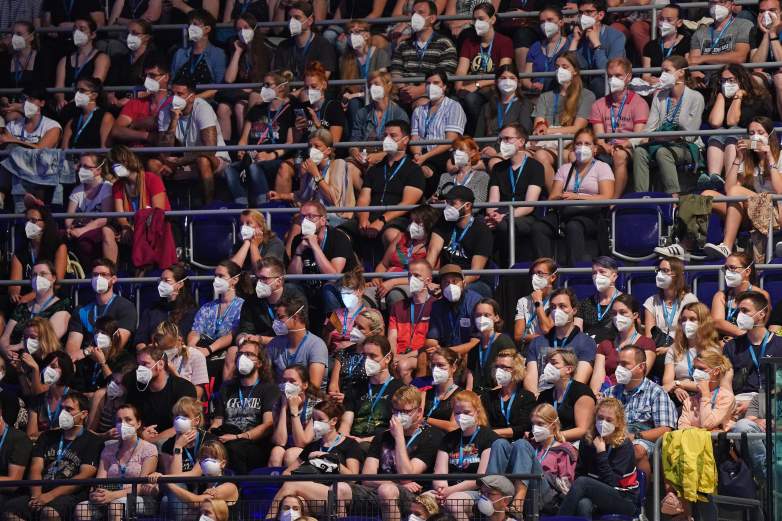
If coronavirus is often spread by breathing in respiratory droplets from infected people, then it stands to reason that avoiding breathing those droplets is key to not getting COVID-19. One way to do that, according to a new study, is to keep humidity levels in indoor settings at 40 to 60 percent.
Researchers from the Leibniz Institute for Tropospheric Research (TROPOS) in Leipzig and the CSIR National Physical Laboratory in New Delhi came to this conclusion after analyzing 10 international studies that were done between 2007 and 2020 looking at the rate of survival and infections of coronaviruses and influenza based on humidity levels in the air.
What they say they discovered is “at higher humidity, the droplets grow faster, fall to the ground earlier and can be inhaled less by healthy people,” meaning that viruses cannot spread as easily in humid conditions.
The New Study Is Among Mounting Evidence That Shows Coronavirus Can Linger in Air and Infect People Who Inhale it & It’s Not Just Transferred Directly From Person to Person

GettyParticipants wearing FFP2 protective face masks take part in the RESTART-19 Covid transmission risk assessment study in a concert setting at an indoor arena during the coronavirus pandemic on August 22, 2020 in Leipzig, Germany. The study, organized by the University Hospital of Halle (Saale), simulates a live concert venue with several thousand audience members in three different scenarios in order to develop risk reduction measures for large events. Participants wear tracer devices to track their movements and sensors measure aerosol currents in the arena. All participants had to undergo a Covid-19 test within the last 48 hours and test negative in order to take part.
The new conclusions echo other researchers’ findings, yet according to the Journal, Nature, key health agencies like the World Health Organization have been slow to accept this evidence or to issue guidance to reflect that the coronavirus can linger in the air in certain settings where it can spread even after a person has left the building.
In May, the WHO said, “At present, there is no strong evidence to suggest that a well-maintained air conditioning, ventilation, or other type of climate control system will contribute to the transmission of COVID-19.”
But by July, the WHO changed its tune a bit, saying, “We have to be open to this evidence and understand its implications regarding the modes of transmission, and also regarding the precautions that need to be taken,” according to Nature.
That was a day after commentary was published by two researchers from the University of Oxford Press and endorsed by 239 other scientists from around the world that said there is plenty of evidence the virus is airborne yet no precautions are being taken to interrupt that means of transmission.
The commentary titled, It is Time to Address Airborne Transmission of COVID-19 said,
It is understood that there is not as yet universal acceptance of airborne transmission of SARS-CoV2; but in our collective assessment there is more than enough supporting evidence so that the precautionary principle should apply. In order to control the pandemic, pending the availability of a vaccine, all routes of transmission must be interrupted.
We are concerned that the lack of recognition of the risk of airborne transmission of COVID-19 and the lack of clear recommendations on the control measures against the airborne virus will have significant consequences: people may think that they are fully protected by adhering to the current recommendations, but in fact, additional airborne interventions are needed for further reduction of infection risk.
The New Study’s Authors Urge the Implementation of Standards for Indoor Air Humidity in Rooms Where Many People Congregate

A team member at the ‘Grosvenor Casino Leo’ prepares a roulette table for play, equipped with perspex screens to partition adjacent players in order to provide a Covid-safe environment, in Liverpool, north west England on August 17, 2020. – Casinos and bowling alleys were allowed to reopen at the weekend as indoor theatres and music venues are to resume with socially distanced audiences after being shut during the lockdown.
Because scientists understand the way particles are affected by the conditions in the air, they say that ignoring this mode of transmission is a mistake, especially with winter coming, because heaters, like air-conditioners, dry out the air.
Dr. Ajit Ahlawat said in the new study titled, Coronavirus SARS-CoV-2 spreads more indoors at low humidity, “If the relative humidity of indoor air is below 40 percent, the particles emitted by infected people absorb less water, remain lighter, fly further through the room and are more likely to be inhaled by healthy people. In addition, dry air also makes the mucous membranes in our noses dry and more permeable to viruses.”
It is the recommendation of the researchers, “To contain the COVID-19 pandemic, it is therefore extremely important to implement standards for indoor air humidity in rooms with many people, such as hospitals, open-plan offices or public transport.”